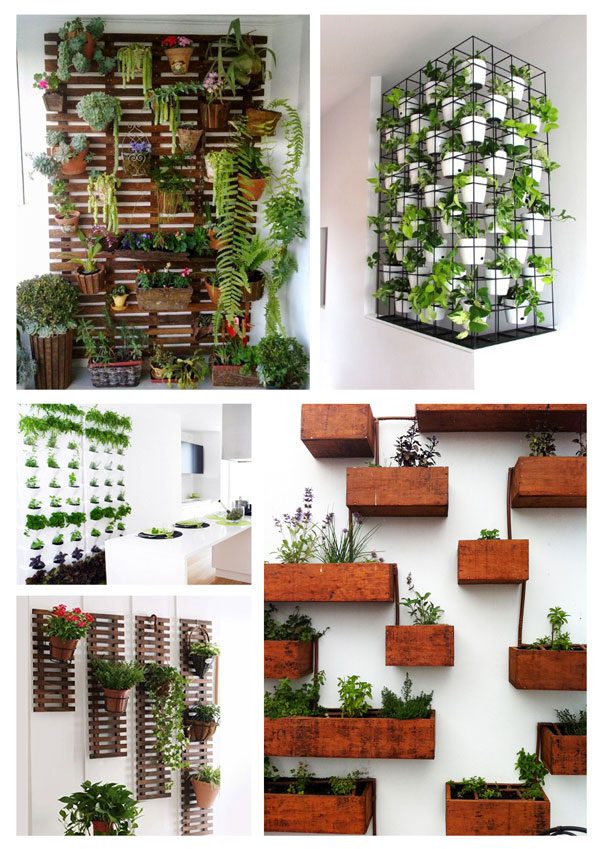It’s never a bad time to start an indoor garden project, so here’s an excellent DIY vertical garden idea for you. It even has an irrigation system!
Liners

First, you need a liner for the planters so water doesn’t leak all over the floors. It’s possible to make a liner with plastic bags but that can create problems, such as mold, down the road.
A hard plastic liner sized to fit the container is far better. Start with those and then make the box dimensions fit perfectly around them.
I used some window box liners, which are fine if you want the wall planters to be all the same dimensions. Feel free to play with varied shapes and sizes for an interesting design.
Caulk the joining seams and nail holes of the boxes from behind, but the wood still needs sealing so it doesn’t rot or get water stains. You don’t want to grow mushrooms! A paint-on sealer won’t create a food-friendly growing environment; marine varnish is better.
Irrigation
If you’re planning on using an irrigation system, consider using repurposed wood to build a false wall so you can hide the lines, cords, and timers.
Or, simply run them neatly along the edges of the boxes.
Drip irrigation can be made from outdoor irrigation tubing and fittings. Select a 1/2 inch drip line that has no holes in it. Then, make tiny drip holes where you need them with an awl. You can find the materials at any hardware store.
Reservoir
If you’re going to have an indoor vertical garden this cool, the last thing you want to use is a plastic tote tub. Use your imagination! Search thrift stores and garage sales in search of a nifty container that holds water. You can drill holes in the top for your irrigation and aeration lines.
Or, hide that cheap tote reservoir in a battered trunk or cedar chest. Just modify the lid or upper back with holes that your lines and cords fit through. You could also use pallet wood to build a lift-off camouflage cover or build a box with a lid.
*Don’t add the plant shown on the lid or use a recirculation line.
Pump

Naturally, your reservoir needs oxygen. You’ll need a 2-line aquarium pump and a couple of small air stones. Space the stones on the reservoir floor to evenly distribute oxygen in the contents.
You also need a pump to send the water and nutrients up the wall. A small submersible fountain pump will do. You need enough power to give the water head lift to about 6 feet off the floor, maybe 8 if you have 10-foot ceilings.
Don’t let the reservoir water level get too low, or the motor will burn up. Always check the level on a regular basis to keep your plants and equipment happy.
Drainage
If excess water can’t drain, root rot and other diseases are possible along with mold on the potting mix. Adding drainage to growing in potting soil means it should drain to waste rather than recirculating back into the reservoir like you would with hydroponic media. To avoid debris plugging up drip holes in the irrigation tubes, you need a slop pot to hold drainage too.
If you don’t want a slop pot, you’ll have to water carefully in non-draining containers. Small plants need less water than they will after developing larger root systems. And some herbs prefer drier conditions than others too.
Once you know how much is enough to moisten the container soil without making a bog in the bottom, plant your wall. Adding gravel is smart, but make sure you use shelf brackets and heavy-duty anchor bolts to handle the extra weight in the planter.
Grow Lights

For better growing results, you really need enough light to provide your plants with sufficient energy to do their job.
Indoors, hang the planters near a window with a lot of natural light. Most people will need some LEDs worked into the indoor vertical garden plan.
LED tape grow lights would be easiest if you add them and maintain the aesthetics. A daylight spectrum LED bulb also works well.
How many you need depends on how many boxes and rows you have.
It might sound complicated, but this way, you can enjoy all kinds of herbs and colorful flowers all year round!
Updated by Catherine Sherriffs on 04/21/2020